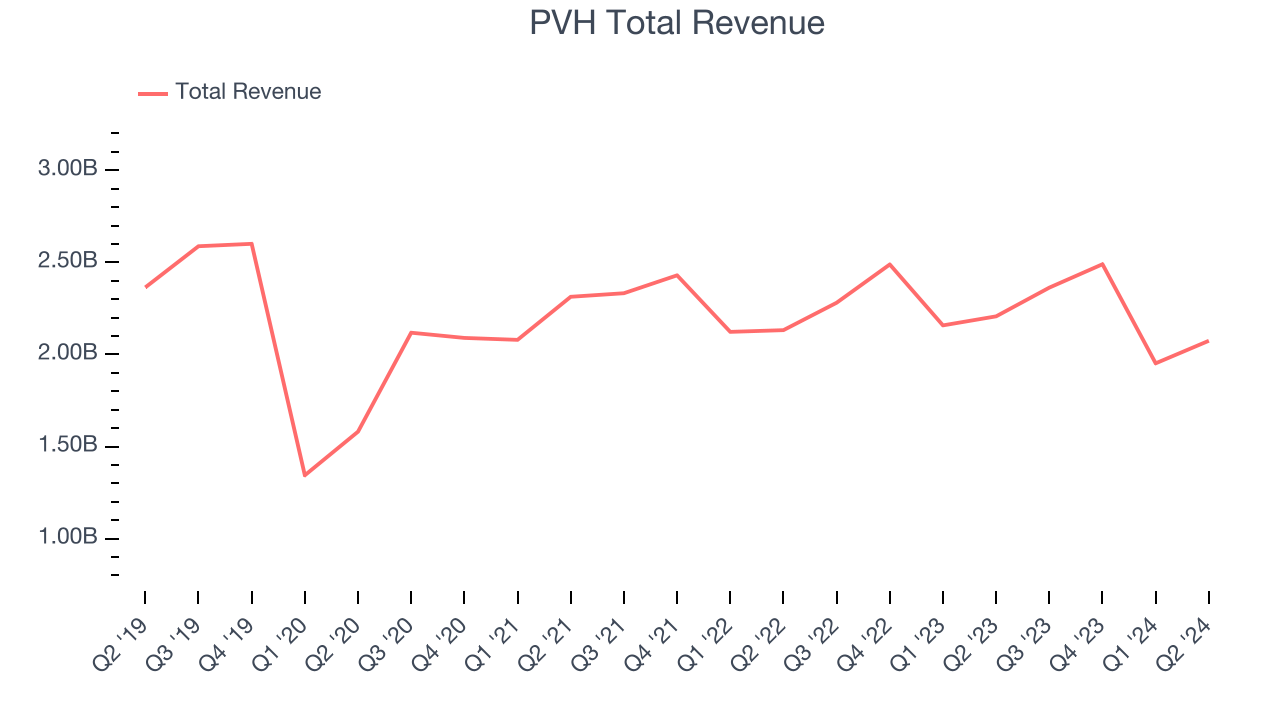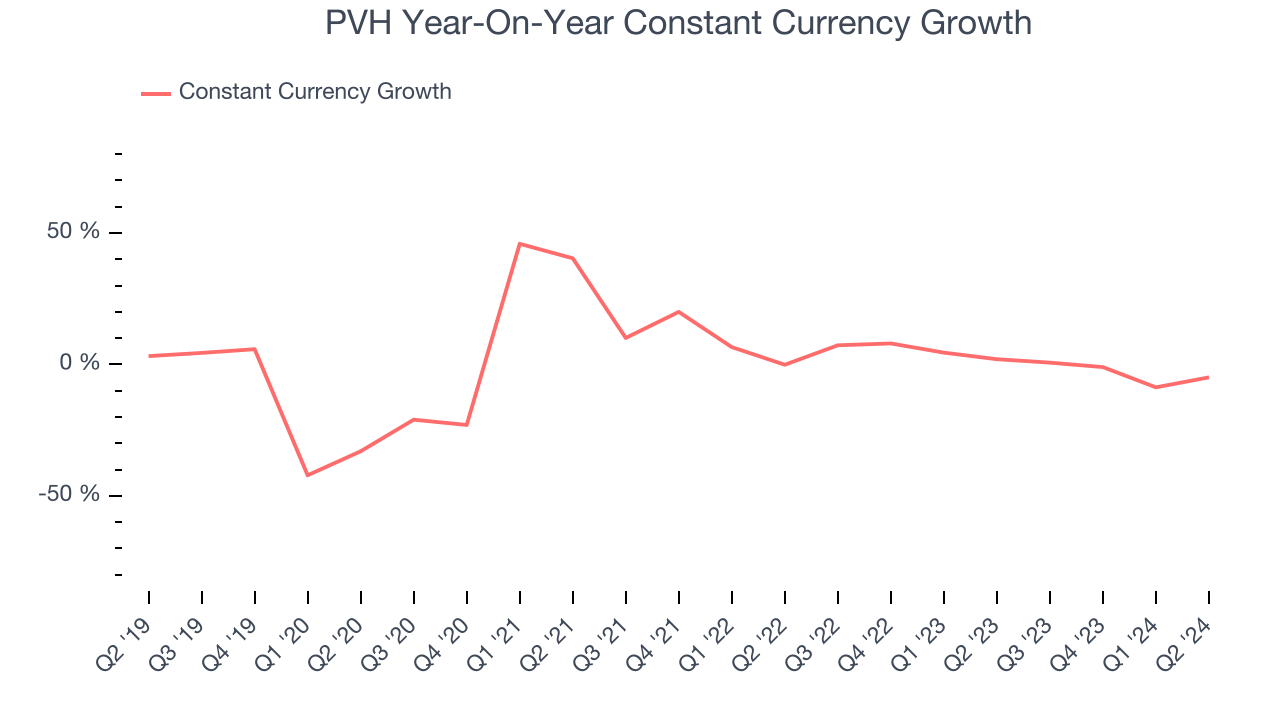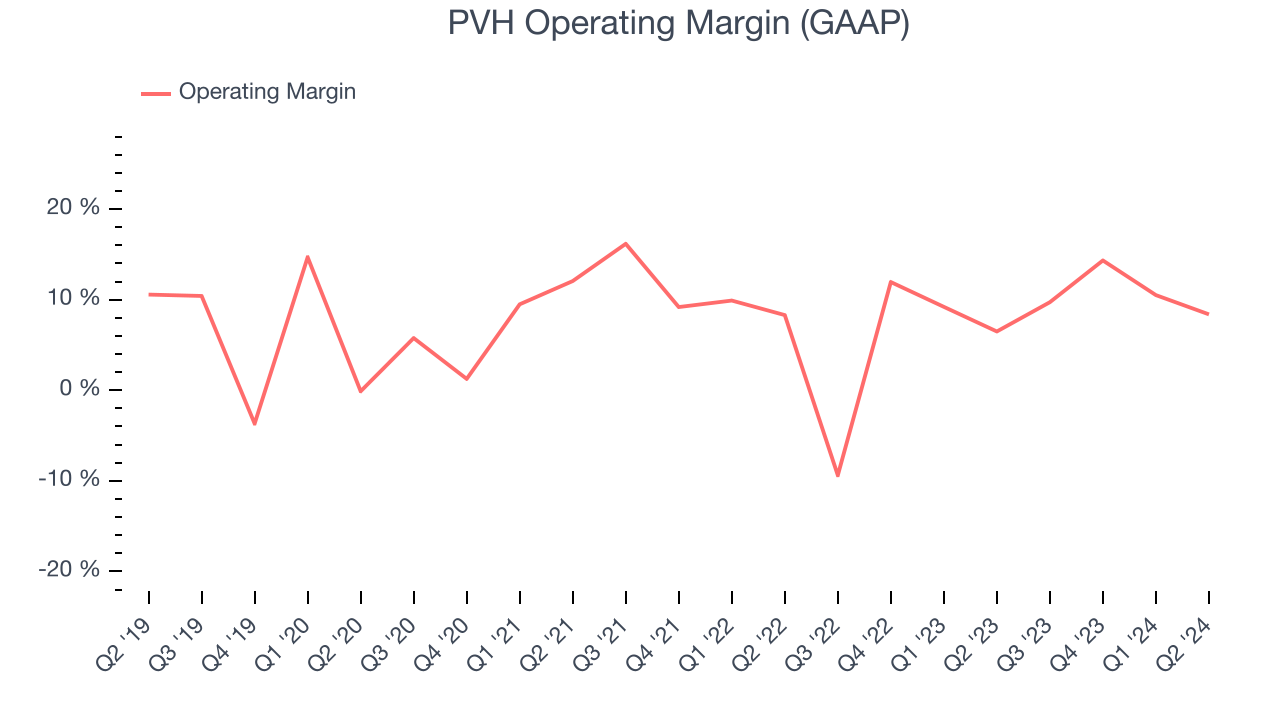Fashion conglomerate PVH (NYSE:PVH) reported results in line with analysts’ expectations in Q2 CY2024, with revenue down 6% year on year to $2.07 billion. It made a non-GAAP profit of $3.01 per share, improving from its profit of $1.98 per share in the same quarter last year.
Is now the time to buy PVH? Find out by accessing our full research report, it’s free.
PVH (PVH) Q2 CY2024 Highlights:
- Revenue: $2.07 billion vs analyst estimates of $2.07 billion (small beat)
- EPS (non-GAAP): $3.01 vs analyst estimates of $2.28 (32.3% beat)
- EPS (non-GAAP) guidance for the full year is $11.68 at the midpoint, beating analyst estimates by 2.8%
- Gross Margin (GAAP): 60.1%, up from 57.6% in the same quarter last year
- Constant Currency Revenue fell 4.9% year on year(compared to 2% in the same quarter last year)
- Market Capitalization: $5.79 billion
Stefan Larsson, Chief Executive Officer, commented, “We delivered on our top- and bottom-line commitments and beat our earnings guidance for the second quarter, led by our disciplined execution of the PVH+ Plan. For both Calvin Klein and Tommy Hilfiger, we drove strong consumer engagement and continued to increase product strength and improve newness in our assortment, leading to more full-priced selling and less end-of-season clearance sales, which fueled significant gross margin expansion.”
Founded in 1881 by a husband and wife duo, PVH (NYSE:PVH) is a global fashion conglomerate with iconic brands like Calvin Klein and Tommy Hilfiger.
Apparel, Accessories and Luxury Goods
Within apparel and accessories, not only do styles change more frequently today than decades past as fads travel through social media and the internet but consumers are also shifting the way they buy their goods, favoring omnichannel and e-commerce experiences. Some apparel, accessories, and luxury goods companies have made concerted efforts to adapt while those who are slower to move may fall behind.
Sales Growth
A company’s long-term performance can indicate its business quality. Any business can put up a good quarter or two, but many enduring ones tend to grow for years. PVH’s demand was weak over the last five years as its sales fell by 1.8% annually, a rough starting point for our analysis. 
Long-term growth is the most important, but within consumer discretionary, product cycles are short and revenue can be hit-driven due to rapidly changing trends and consumer preferences. PVH’s revenue over the last two years was flat, sugggesting its demand was weak but stabilized after its initial drop in sales.
We can better understand the company’s sales dynamics by analyzing its constant currency revenue, which exclude currency movements that are outside the company’s control and not indicative of demand. Over the last two years, its constant currency sales were flat. Because this number is better than its normal revenue growth, we can see that foreign exchange rates have been a headwind for PVH. 
This quarter, PVH reported a rather uninspiring 6% year-on-year revenue decline to $2.07 billion of revenue, in line with Wall Street’s estimates. Looking ahead, Wall Street expects revenue to decline 1.2% over the next 12 months.
Today’s young investors won’t have read the timeless lessons in Gorilla Game: Picking Winners In High Technology because it was written more than 20 years ago when Microsoft and Apple were first establishing their supremacy. But if we apply the same principles, then enterprise software stocks leveraging their own generative AI capabilities may well be the Gorillas of the future. So, in that spirit, we are excited to present our Special Free Report on a profitable, fast-growing enterprise software stock that is already riding the automation wave and looking to catch the generative AI next.
Operating Margin
Operating margin is a key measure of profitability. Think of it as net income–the bottom line–excluding the impact of taxes and interest on debt, which are less connected to business fundamentals.
PVH’s operating margin has risen over the last year and averaged 7.7%. The company’s higher efficiency is a breath of fresh air, but its suboptimal cost structure means it still sports paltry profitability for a consumer discretionary business.

In Q2, PVH generated an operating profit margin of 8.4%, up 1.9 percentage points year on year. This increase was a welcome development, especially since its revenue fell, showing it was recently more efficient because it scaled down its expenses.
Key Takeaways from PVH’s Q2 Results
We were impressed by how significantly PVH blew past analysts’ EPS expectations this quarter. We were also glad its full-year earnings guidance exceeded Wall Street’s estimates. On the other hand, next quarter's EPS guidance missed, raising some skepticism. Overall, the areas below expectations seem to be driving the stock move, and shares traded down 6.2% to $97.99 immediately following the results.
So should you invest in PVH right now? When making that decision, it’s important to consider its valuation, business qualities, as well as what has happened in the latest quarter. We cover that in our actionable full research report which you can read here, it’s free.
